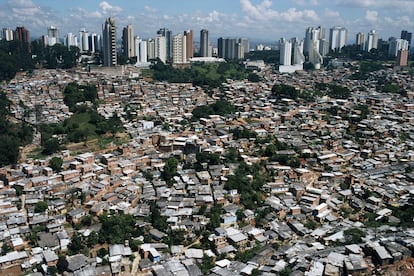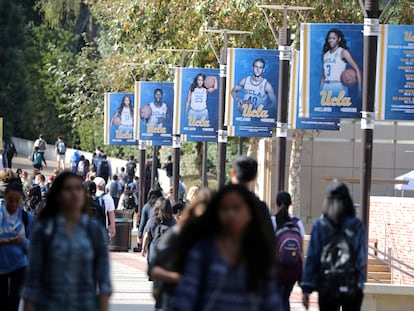Affirmative action in Brazilian universities: ‘I am living proof that quotas work’
Legislators have reached an agreement to extend a system that has brought about a shift, making lower-middle class students the majority


Milena Hildete Teixeira, a 27-year-old Brazilian, will never forget the day when she was invited to be on the interview panel for Roda Viva. The prestigious TV program showcases influential figures, who spend two hours answering questions from journalists. “That day, the whole neighborhood stopped what they were doing to watch me on the program. It was very cool!” This young woman grew up in a favela — a slum — where dreaming of a bright future was a rare luxury. Journalism didn’t even cross her mind until a teacher said it would a good career path for someone with her outgoing personality. Taking a chance, she applied with little confidence to a university program and was admitted. Now she’s the pride of the family and its first college graduate.
Teixeira’s time at the university changed her life. The pivotal factor that provided her with this crucial opportunity is the quota system that has been in place for a decade. This affirmative action system reserves 50% of admissions to the top Brazilian public universities for students from public high schools, with a priority on those from disadvantaged backgrounds: poor, Black, Mestizo and Indigenous students. “I am living proof that quotas work. I personally think Brazil has really excelled in this,” she told us in a video call from Brasília, where she now works as a journalist covering the National Congress.
Two months after the United States Supreme Court dealt a blow to race-based affirmative action in higher education, Brazil reaffirmed and extended its own system. Brazil’s National Congress, dominated by white, middle-aged men, made the momentous decision on August 9 and Teixeira was there to report it for the CBN radio station. Two other prominent women were there that day, who also say university admission quotas gave them unique opportunities: Dandara Castro, a 29-year-old legislator from President Lula’s Workers’ Party, and 39-year-old Anielle Franco, Brazil’s Minister of Racial Equality.
The recently approved update to the quota system has made significant changes. It permanently establishes socio-racial quotas, subject to review every 10 years. It also broadens the eligibility criteria for family income to ensure that it benefits not only the wealthy, but also includes quilombolas — descendants of rebellious slaves who live in communities established centuries ago. There were concerns that Brazil’s most conservative Congress ever would eliminate policies that benefit people with historically limited opportunities.
The implementation of quotas, along with significant expansion of higher education advocated by the Workers’ Party, has led to unprecedented diversity in university classrooms. These classrooms now better reflect the demographics of Brazil compared to the beginning of the 21st century. Previously, upper-class whites made up 55% of the student body. However, a recent study by the Nexo digital news outlet revealed that lower- and middle-class Mestizo and Black students now make up the same percentage. In other words, the number of non-white students has quadrupled to 1.2 million in just 20 years.

Teixeira’s mother runs a tiny bar in Salvador (northeast Brazil) and her father does odd jobs. Both have limited schooling, and made significant sacrifices for their daughter to enroll at the Federal University of Bahia. Every day, Teixeira had to commute two hours each way to the university. During her senior year in high school, there was no language-skills teacher for three months, and Teixeira was worried when she started college. “I didn’t talk at all. I was scared of saying something wrong, of making mistakes.” The classrooms were full of white students in Brazil’s Blackest state capital — Salvador was one of the main ports of entry for slave ships from Africa.
“I have always seen quotas as a form of reparation. I believe I should be compensated because my ancestors were enslaved,” said this young professional who proudly wears curly hair that generations of Black women diligently straightened. After slavery was abolished in 1888, Brazilian Blacks were left without land, education or job opportunities. Meanwhile, the government attracted European and Japanese immigrants by offering them land and credit.
Teixeira, Franco, and Castro represent a generation that has revolutionized Brazilian society. Despite being children of domestic workers, they have earned degrees in fields like law, sociology and medicine. Their rapid ascent is remarkable considering they live in one of the world’s most unequal countries with the lowest level of social mobility. According to a study by the Organization for Economic Cooperation and Development (OECD), it takes nine generations to move from poverty to middle class in Brazil, whereas in Denmark, only two generations are required.
“The first time I went to the dentist, I was 22 years old and working!” exclaimed Teixeira. When she decided to attend university, she anticipated a positive change in her life. But she never imagined the transformation would be so profound. “It changed everything, you know why? It changes your focus, the way you talk, dress, comb your hair, eat... It gives you access to other spaces and other perspectives on life.” Living and working in the heart of Brazil’s modern capital city wasn’t just an unattainable dream — it never even crossed her mind. Expectations were as short as the walk to the corner store.
Like India, Brazil has highly regarded public universities, while basic education is severely lacking. Higher education was once the purview of privileged Brazilians who worried about their children’s prospects and loudly protested when quotas were introduced in 2012. However, a decade later, few voices advocate for abolishing quotas, despite the predictable right-wing grumbling.
Rachel Quintiliano, a strong advocate for gender and race equality, says that the current system not only leads to personal and family advancement but also contributes to the country’s overall development and progress. A columnist for Raça magazine, she said, “Quotas play a crucial role in reducing inequality by nurturing an intellectual elite. Increasing the representation of Blacks in [positions of power] over the next 15 or 20 years will lead to more equitable laws.” She acknowledges that earning a college degree is only the first step, as job opportunities remain scarce. “There is persistent racism here, along with many other barriers and daily micro-violence.”
The impact of quotas in Brazil is significantly greater than in the U.S. because over half of Brazil’s population is comprised of Blacks and Mestizos, while African Americans make up only 14% of the U.S. population. Segregation was also much more severe in the U.S., so racial identification is more challenging. Brazil implemented a self-identification process, demonstrating an impressively low rate of fraudulent self-identification at just 1%. When there is uncertainty regarding a student’s racial identification, a procedure named “hetero-identification” is utilized. Initially criticized as racial tribunals, their decisions are ultimately decisive.
Sign up for our weekly newsletter to get more English-language news coverage from EL PAÍS USA Edition
Tu suscripción se está usando en otro dispositivo
¿Quieres añadir otro usuario a tu suscripción?
Si continúas leyendo en este dispositivo, no se podrá leer en el otro.
FlechaTu suscripción se está usando en otro dispositivo y solo puedes acceder a EL PAÍS desde un dispositivo a la vez.
Si quieres compartir tu cuenta, cambia tu suscripción a la modalidad Premium, así podrás añadir otro usuario. Cada uno accederá con su propia cuenta de email, lo que os permitirá personalizar vuestra experiencia en EL PAÍS.
¿Tienes una suscripción de empresa? Accede aquí para contratar más cuentas.
En el caso de no saber quién está usando tu cuenta, te recomendamos cambiar tu contraseña aquí.
Si decides continuar compartiendo tu cuenta, este mensaje se mostrará en tu dispositivo y en el de la otra persona que está usando tu cuenta de forma indefinida, afectando a tu experiencia de lectura. Puedes consultar aquí los términos y condiciones de la suscripción digital.
More information
Archived In
Últimas noticias
Most viewed
- David King, chemist: ‘There are scientists studying how to cool the planet; nobody should stop these experiments from happening’
- Reinhard Genzel, Nobel laureate in physics: ‘One-minute videos will never give you the truth’
- Mexico completes its trade shift with the entry into force of tariffs on China and countries without trade agreements
- Oona Chaplin: ‘I told James Cameron that I was living in a treehouse and starting a permaculture project with a friend’
- Sinaloa Cartel war is taking its toll on Los Chapitos










































